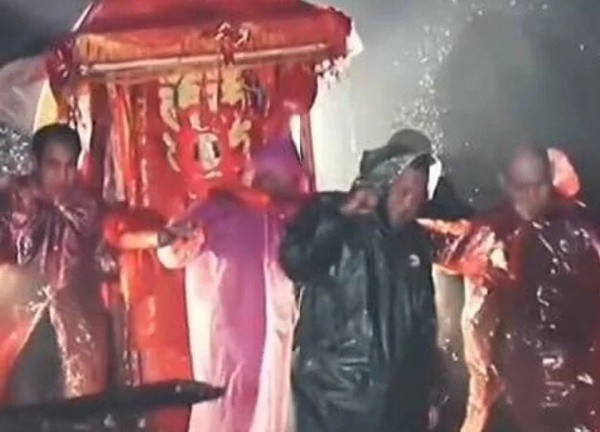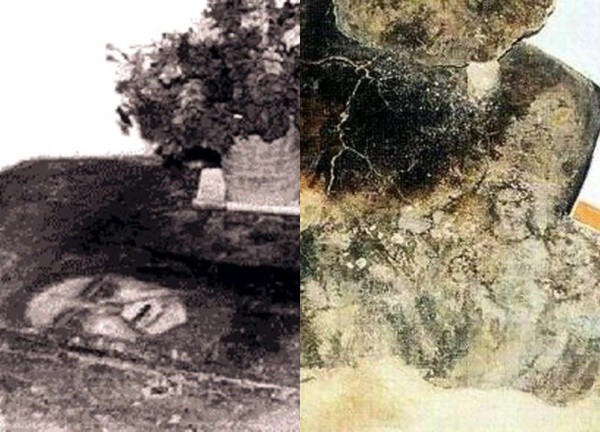Strange wedding procession at 2am, many people are "threatened" because they think "ghost wedding"

4 | 1 Discuss | Share
These doors are not intended as a place to enter or exit but have a deeper meaning. And indeed, later generations respected them no matter what and did not seek to discover the secrets within them.
Gates in architectural works, especially scenic spots such as temples, carry important meanings. They are not only entrances and exits but also barriers to ensure safety. In ancient times, the development of cities was inseparable from the existence of city gates. When the city gates are closed, the city becomes a strong fortress against external threats, whether it is enemy invasion or natural disasters.
But some doors seem different from others. They don't seem to exist to open. These doors are hidden in mysterious places, leading to unknown areas and seem to require a special key or password to open. These doors are not intended as a place to enter or exit but have a deeper meaning.
In the world, there are 3 doors that are known as "unopenable", and indeed later generations have respected them and not sought to discover the secrets inside them.
Taj Mahal
The first door is India's famous Taj Mahal. The Taj Mahal is an iconic landmark in India and was voted one of the 7 wonders of the world. The Taj Mahal was built by Shah Jahan of the Mughal dynasty in memory of his beloved concubine. The king was extremely saddened by the death of his concubine, so he mobilized tens of thousands of people and more than 10 years to build the Taj Mahal.
The splendor of the Taj Mahal is unparalleled. Because Shah Jahan wanted to preserve his love for his wife forever, he built this mausoleum 508 meters long and 350 meters wide. For this purpose, he almost exhausted the wealth of the dynasty.
Today, the Taj Mahal is India's national treasure and no one is allowed to open its main gate. Legend has it that the Taj Mahal contains the bodies of Shah Jahan and his concubines as well as endless treasures.
Padmanabhaswamy Temple
In Kerala, southern India, there is a mysterious and peculiar hidden temple called Padmanabhaswamy, which has long been a holy place for people to worship. Deep inside the temple there are 6 sealed rooms. When posterity opened one of the secret rooms, they were overwhelmed because these were rooms containing treasure. Preliminary estimates by archaeological experts say that the value of these treasures is more than 10 billion USD. However, Indians do not use these treasures but still keep them in temples.
Although secret rooms have been opened and a large amount of treasures and ancient artifacts have been discovered, the 6th door has never been opened. On the one hand, because the first 5 secret rooms kept archaeologists busy and there was no time to open the 6th secret room. On the other hand, the opening of the last room was postponed due to financial difficulties. method.
Mausoleum of Qin Shi Huang
In China - a country with a long-standing culture, the door that "cannot be opened" is the Mausoleum of Qin Shi Huang. Since the discovery of the Mausoleum of Qin Shi Huang, people have been full of curiosity about the cultural relics inside it, but opening the mausoleum is extremely difficult.
Although it lay there for more than 2,000 years, after its death on September 10, 210 BC, the tomb was said to hold all the answers to the unanswered secrets of history, but until Up to now, no modern person has ever observed the inside of this place and that depends not only on the government but also on science.
When he died, Qin Shi Huang was buried in the most elaborate mausoleum ever built in China. Located north of Lishan Mountain, Shaanxi Province, it is a complex submerged architectural block, containing everything the emperor needed for "life" after death. In 1974, some farmers digging a well near Xi'an were surprised to find one of the most shocking discoveries in archaeological history.
Construction on Qin Shi Huang's mausoleum began in the first year he ascended the throne and took 39 years to complete. During this time, the Qin state unified the world, making the mausoleum much more luxurious than imagined.
According to an archaeological survey in 1962, the area of Emperor Qin Shi Huang's Mausoleum is at least more than 56 square kilometers. This is not just an isolated tomb but also a huge tomb complex with more than 400 tombs scattered around, a huge archaeological discovery.
The terracotta warriors and horses guarding the outside of the Mausoleum of Emperor Qin Shi Huang have attracted world attention. Although experts have firmly determined their general structure through modern tools, they still made mistakes during excavation and research, causing the Terracotta Warriors and Horses to fade. To avoid similar mistakes happening to the Mausoleum of Qin Shi Huang, experts do not dare to open it rashly.
Another problem is that the Mausoleum of Qin Shi Huang has a lot of mercury, which is extremely toxic. Over the years, much of the mercury in the tomb evaporated and nearby trees produced toxic fruit. These difficulties and risks make the Mausoleum of Qin Shi Huang a "door" that cannot be easily opened, and people are still full of infinite curiosity for the secrets inside.
A woman meets a young man who looks exactly like her deceased son. When she asks for information, she gets angry  Quỳnh Quỳnh18:15:56 20/03/2024The story shared touched many people. At the same time, I can't help but be surprised that there are two people who are so similar. Not only their appearance but also their personal information are incredibly similar.
Quỳnh Quỳnh18:15:56 20/03/2024The story shared touched many people. At the same time, I can't help but be surprised that there are two people who are so similar. Not only their appearance but also their personal information are incredibly similar.

4 | 1 Discuss | Share

1 | 1 Discuss | Share

14 | 1 Discuss | Share

4 | 1 Discuss | Share

6 | 1 Discuss | Share

4 | 1 Discuss | Share

1 | 1 Discuss | Share

3 | 1 Discuss | Share

2 | 1 Discuss | Share

2 | 1 Discuss | Share

4 | 1 Discuss | Share

2 | 1 Discuss | Share










3 | 1 Discuss | Report